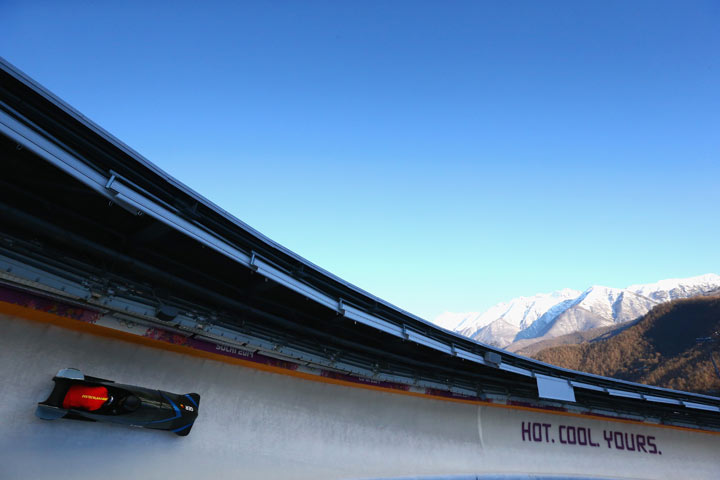Terry Gudzowsky knows bobsled.

As a former member of the Canadian national team, a coach, and former director of the Canadian Olympic Committee, the Canadian president of Sochi track design consortium ISC/IBG Group knows what he likes in a track.
And Sochi definitely fits the bill, he said.
“It’s a good-looking track, I’ll say that. Of course I’m biased.”
First, you start with what Mother Nature gave you. “We have a great physical setting on a treed slope,” he said. The track rises up the hill from a river valley.
“This site is very compact. It’s relatively steep. It’s not very long, it’s not very wide.” This limited the kinds of design elements that could be incorporated.
“On this track you have 17 corners and what’s unique about it is that there are three uphill sections,” he said. Although having uphill sections isn’t unique, having three of them is. “The third one at the bottom actually had to be put in because the bottom area wasn’t big enough to design what we normally do, like a big, sweeping corner,” he said.
“So the track had to rise over itself, like an overpass on a highway, where you go up and over and then you come back underneath in the braking section.”
The setting provided an additional challenge: “It’s the warmest, or relatively the warmest area that a track’s been built in,” Gudzowsky said. So the refrigeration system had to be especially robust to keep the track from becoming a waterslide. Not only that, unusually large roofs were built to shade the track from the sun – so large that spectators can actually stand underneath them.
Once the track site’s limitations are accounted for, then designers think about the sporting challenge.
Gudzowsky prefers what he calls a “technical” track, meaning one that requires a high degree of driving skill to quickly navigate. “On some tracks, if you have a great start and a reasonable drive, it’s tough to beat somebody – it’s skewed to the start,” he said. “Most good athletes would rather see a better distribution.
“I always liked the technical tracks. The ones that are a real challenge. I had confidence in my abilities. If it’s a good technical track, I can be on top.”
The three uphill sections present that challenge for the pilots. Although Nagano had a large uphill section, he said, most bobsledders today haven’t driven on that track. “So it’s a new experience for them. Doing that, driving out of an uphill like after an uphill section, it requires a subtlety that you don’t normally experience.
“Normally, you’re used to going downhill all the time. But all of a sudden you’ve got these little tweaks, a few really interesting parts in this track, that I think will divide the medallists from the rest of the pack.”
While uphill sections do slow things down, the difference is relative, he said. “When you go through these uphill sections, you drop the speed by 10 km/h, but you pick that back up. It doesn’t slow you down for the whole course.” In test events, top speeds were at about 135 km/h in some sections. Sochi is still one of the fastest tracks in the world, according to Gudzowsky.
Of course, speed can bring danger, as seen when Georgian luger Nodar Kumaritashvili flew off the track during a training run in Whistler and died, on the opening day of the Vancouver Olympics. (Luge, bobsled and skeleton all use the same track, just different entry points)
The bobsleigh and luge federations wanted a slower track for Sochi, said Gudzowsky, and although the plans were largely finished before the Vancouver Olympics started, the designers did incorporate this wish by adding more uphill sections.
Accidents are common in the sliding sports, he said. “There are always situations that occur in any sport. That just happens.”
“I don’t anticipate any problems of any sort with any of the sliders there. But can someone crash? Sure. Every track has had crashes on pretty much any corner.”
Gudzowsky is excited to watch his company’s track in action though. “I think it’s going to be a great competition in all the disciplines.”
The bobsleigh events continue Monday with the final two heats in the two-man bobsleigh starting at 9:30 a.m. Eastern time (6:30 a.m. Pacific).











Comments